Home | Surgical Info | Hip Joint Subluxations in Dogs
Hip Joint Subluxations in Dogs
Keywords:
Hip Joint Luxation in Dogs
What is a hip joint subluxation?
Hip luxation, also known as hip dislocation, occurs when the head of the femur (thigh bone) is displaced from the hip socket (acetabulum). This painful condition is usually caused by trauma, such as a fall, accident, or severe joint disease, and leads to lameness, joint instability, and discomfort.
If left untreated, hip luxation can result in arthritis, chronic pain, and mobility issues, making early diagnosis and treatment essential.
At Canton Animal Hospital, we offer advanced diagnostic tools and treatment options, including closed reduction, surgical repair and FHO, to restore your pet’s comfort and mobility.
Trauma, such as an automobile accident, is the most common cause of sudden or acute joint subluxations.
Causes of Hip Luxation in Dogs
Hip luxation is most commonly caused by trauma or underlying joint conditions, including:
Car accidents or falls – High-impact injuries can force the femur out of the hip socket.
Hip dysplasia – Dogs with existing joint abnormalities are more prone to dislocation.
Ligament or joint capsule damage – Weakening of supporting structures can contribute to instability.
Congenital conditions – Some breeds are genetically predisposed to hip joint issues.
Featured Resources

We Welcome New Patients!
We're always happy to give your furry friend care at our hospital. Get in touch today!
Contact Us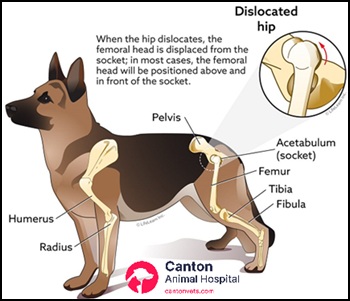
Signs & Symptoms of Hip Luxation
If your dog has a dislocated hip, you may notice:
Sudden, severe limping or complete non-weight bearing on one leg
Leg held in an abnormal position (rotated outward or inward)
Visible asymmetry in the hips (one hip appears higher or lower)
Pain and sensitivity when the hip is touched
Decreased mobility and reluctance to walk or climb stairs
If you suspect your dog has suffered hip luxation, seek veterinary care immediately to prevent complications.

Diagnosis of Hip Luxation in Dogs
A veterinarian will diagnose hip luxation using:
Physical examination – Checking for joint instability and abnormal leg positioning.
X-rays (radiographs) – Confirming hip dislocation and assessing joint damage.
Palpation tests – Identifying pain, swelling, or movement restrictions.
Early diagnosis improves treatment success rates and prevents long-term joint damage.
Hip Luxation Treatment in Dogs
Hip luxation (dislocated hip) in dogs is typically treated through closed reduction, open reduction, or surgical procedures, depending on the severity of the injury.
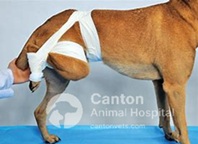
Treatment Options:
1. Closed Reduction (Non-Surgical Treatment)
Procedure: The veterinarian manually repositions the hip joint under anesthesia.
Best For: Recent dislocations without fractures or joint damage.
Post-Treatment: The dog wears an Ehmer sling for 10-14 days to keep the joint in place.
Limitations: Hip may re-dislocate if soft tissues are severely damaged.
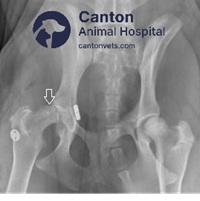
2. Open Reduction (Surgical Repair)-Toggle Pin Fixation
Procedure: Surgical intervention to restore hip stability using ligament repair or toggle pin fixation.
Best For: Chronic dislocation failed closed reductions, or severe instability. Restores immediate joint stability
Recovery: Strict rest for 4-6 weeks, followed by Gradual rehabilitation and physical therapy to regain strength and range of motion.
Recheck X-rays are performed at follow-up visits to monitor implant positioning
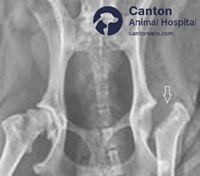
3. Femoral Head Ostectomy (FHO Surgery)
Procedure: The femoral head is surgically removed, allowing a false joint to form.
Best For: Dogs with chronic dislocation, hip dysplasia, or severe arthritis.
Recovery: Dogs adapt well, with most regaining pain-free mobility.
Benefits: Relieves chronic hip pain and discomfort, improves limb use and overall quality of life. Lower cost and fewer risks compared to total hip replacement, no need for implants, reducing complication risks. Effective long-term outcomes for most cats and small dogs
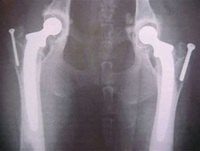
4. Total Hip Replacement (THR Surgery)
Procedure: The damaged hip joint is replaced with a prosthetic implant.
Best For: Large breed dogs with severe arthritis or chronic luxation.
Outcome: Restores near normal mobility and joint function.
Early treatment is crucial to prevent arthritis and long-term mobility issues. If your dog has a dislocated hip, consult a veterinarian immediately for the best treatment plan.
Recovery & Post-Surgical Care
Regardless of the treatment method, proper post-operative care is essential for a full recovery:
Strict rest & activity restriction for 4-6 weeks
Pain management & anti-inflammatory medications
Physical therapy & rehabilitation exercises
Weight management to reduce stress on joints
Following veterinary recommendations ensures a successful recovery and long-term joint health.
Preventing Hip Luxation in Dogs
While some cases of hip luxation are unavoidable, you can reduce your dog's risk by:
Preventing trauma – Keep dogs on leashes in high-traffic areas and avoid risky activities.
Maintaining a healthy weight – Excess weight strains the hip joints.
Providing joint supplements – Glucosamine and omega-3s support joint health.
Regular vet checkups – Early detection of joint issues can prevent complications.
Featured Resources

We Welcome New Patients!
We're always happy to give your furry friend care at our hospital. Get in touch today!
Contact UsFrequently Asked Questions (FAQS) about Hip Dislocation
Hip luxation, or hip dislocation, occurs when the femur’s head slips out of the hip socket, causing pain, lameness, and mobility issues. If left untreated, it can lead to arthritis and long-term joint damage. Below are important FAQs about hip luxation in dogs, covering causes, symptoms, treatment, and recovery.
